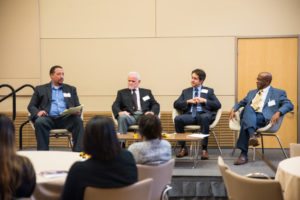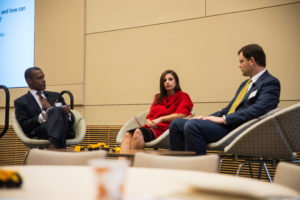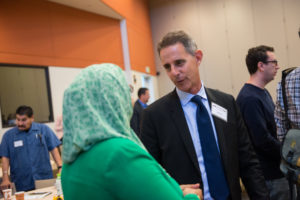Applying lessons from gang violence to preventing extremism explained at conference
By Jillian SlutzkerOctober 6, 2016
“It appears to me that while the diagnosis seems to be somewhat different, we seem to be applying the same solution that did not work [with gangs] to violent extremism.”
LOS ANGELES – Once plagued by epidemic levels of gang violence, this city knows a thing or two about reducing violence and countering violent extremism.
When Guillermo Cespedes took the office of Deputy Mayor and Director of LA’s Office of Gang Reduction and Youth Development in 2009, high rates of gang-related homicide and crime were plaguing many of the city’s neighborhoods.
It wasn’t until he jumpstarted the city’s four-pillared approach to gang violence that joined social services aimed at prevention, intervention and reintegration with compassionate, constitutional law enforcement that rates of gang-related violence started to fall.
From 2007 to 2014, gang-related crime in the city dropped by almost 50 percent. From 2007 to 2015, gang-related homicides fell by 66.7 percent.
Speaking at the LA Public Safety Conference on Oct. 3, Cespedes and players in the city’s successful violence reduction transformation joined members of law enforcement, civil society and government to share lessons learned and chart a path forward to counter the threat of violent extremism, from gangs to extremists inspired by religious and political ideologies. The conference was sponsored by Southern California Crossroads and Creative Associates International.
Rather than criminalizing gang identity and writing off youth as irredeemable criminals, which in fact strengthened the gangs, Cespedes and his team focused on changing behavior and taking a holistic approach to vulnerable youth and their families. This approach has also been successful in reducing youth risk for joining gangs in Honduras and El Salvador.

Cespedes sees a similar troubling trend in today’s approach to Muslim youth suspected of or vulnerable to membership in violent extremist organization—criminalization is a first line of defense.
“It appears to me that while the diagnosis seems to be somewhat different, we seem to be applying the same solution that did not work [with gangs] to violent extremism,” he said.
Now with Creative, Cespedes is part of the company’s critical thinking on reducing violence, improving citizen security and countering violent extremism.
Enrique Roig, Director of Creative’s Citizen Security Practice Area, stated that Creative has started the implementation of a program in Tunisia to transfer lessons learned from the gang prevention field to a CVE context.
“This will inform future CVE programming with real evidence-informed data,” said Roig.
For almost 40 years, Creative has supported communities to address root causes of violent extremism, spearheading successful development programs in more than 85 countries. Its “whole-of-society” approach engages local, regional, national and international actors in the research, design and implementation of complementary and multi-level approaches to development and countering violent extremism.
Violent extremism beyond a profile
While media headlines tend to focus on cases inspired by ISIS, the threat of violent extremism in the United States includes white supremacists, gang members and others, explained keynote speaker Erroll Southers, former FBI Special Agent and Director of Homegrown Violent Extremism Studies at the University of Southern California.
“There is no profile,” he stated.
Southers noted that prior to June Pulse nightclub massacre in Orlando, carried out by Islamic State-inspired extremist Omar Mateen, the majority of the victims of violent extremist acts in the United States since Sept. 11, 2001 were killed by non-Muslims. These crimes were not motivated by religion but by race or other convictions, such as anti-abortion or anti-government activists.
“We have this laser focused on certain groups, these [other] people often go without mention,” he cautioned.

The LA Public Safety Conference was a critical step in moving beyond the headlines to share best practices to stem violent extremism among a variety of vulnerable populations. It convened experts from a range of fields, including youth gang violence prevention, criminal rehabilitation, radicalization in the Muslim community and international development.
An overemphasis on arrest, rather than preventive services, may also have the unintended effect of deterring concerned friends and family members from reporting a loved one whom they suspect of radicalization to violent extremism.
In light of this, creating “off-ramps” outside of the judicial system for youth on the road to radicalization is critical, explained panelists.
“The vast majority of individuals we’re going to work with are not in the criminal space,” said Joumana Silyan-Saba, Director of Strategies Against Violent Extremism in the Los Angeles Mayor’s Office of Public Safety.
Silyan-Saba called for an expansion of pipelines for referrals for at-risk youth and their families before crimes are committed so they can be rerouted toward a positive path. She cautioned against “labeling and criminalizing” whole communities.
An effective approach to countering violent extremism will require the same type of holistic, public health-based approach that proved successful in lowering levels of gang violence, panelists explained.
A “social autopsy” of violent extremists’ motivations
“Multiple identities build more resilience, and hyphens makes your stronger. But extremists groups are trying to narrow down identity.”
Humera Khan, Executive Director of Muflehun, researches and works with Muslim communities across the United States to prevent and counter violent extremism. She has found that young people tend to seek three common things: identity or their role in life; a sense of belonging; and a sense of purpose.
For youth hungry to fills these voids, violent extremists groups and the absolutist world views they offer can be appealing, especially to youth struggling to balance multiple identities, she explained.
“Multiple identities build more resilience, and hyphens makes your stronger,” said Khan, herself a Muslim-American. “But extremists groups are trying to narrow down identity [and say]: ‘You can only live in this world.’”
Understanding why any of those three factors is not met for an induvial youth will be key to reaching that young person and providing a better, alternative narrative and path forward, said Khan.
“This is not about rational explanations. This is about dealing with humans where they are,” she said.

This story behind an individual’s path to radicalization to violent extremism is what Cespedes calls “a social autopsy” and it is often neglected.
“What happens with a case involving violence and terrorism is our autopsy goes as far as saying ‘he was radicalized’ and the case is closed,” Cespedes said.
Cespedes, Khan and other speakers called this social autopsy essential for understanding drivers toward radicalization and points of intervention.
As former Los Angeles gang member Sammy Rangel knows firsthand, behind each criminal or violent action is an individual’s unique story and the life events and emotions that shaped his/her path.
Rangel, who operates the Formers Anonymous 12-step rehabilitation program for people recovering from criminal behavior, said that understanding the reasons for such actions doesn’t equate to excusing it. But it can help others to improve the chances of reintegration and rehabilitation of offenders and prevent the radicalization of others.
“We just want to be able connect the dots to get to the root cause to get to the root solution,” said Rangel.
Taking a holistic, systems-based approach is also important to understanding larger community dynamics that might affect an individual’s vulnerability to violent extremism, noted Sid Balman, Director of Transnational Initiatives at Creative.
Balman said practitioners and service providers must ask not only what drives individual radicalism but also what causes gaps in community resilience.
“It’s never just one answer,” he said.
Building community trust is critical
For prevention to work successfully alongside law enforcement and to truly address risk factors of vulnerable youth before violence is perpetrated, community engagement and leadership is indispensable, said speakers.
“We have tendency to say we know what a community needs, but the process doesn’t happen that way,” said Silyan-Saba. “It is all about the relationships you build. It’s all about the trust you build.”
While practitioners from the outside can bring in expertise, community members—including faith groups, mental health providers, educators and youth-serving organizations—provide the buy-in, local knowledge and leadership to make a program credible and effective in their communities, speakers explained.
“Effective programs need to be done with and through community interlocutors,” said Paul Turner, Senior Conflict Advisor at Creative who has led programs across the globe to strengthen community resilience. “What we’re really trying to do is ask about what the goals are for individuals and for their communities and those goals are often in lockstep with what we’re trying to accomplish.”
As more funding and focus is poured into efforts to reach the most vulnerable individuals and to keep communities and the country more secure, sharing these best practices among law enforcement, social service providers and community leaders is essential.
“It places some responsibility on all of us,” said Turner. “It’s about building a country with people that are connected and supporting each other.”

